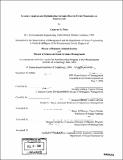| dc.contributor.advisor | Jeremie Gallien and Thomas Roemer. | en_US |
| dc.contributor.author | Price, Cameron S. (Cameron Stalker), 1972- | en_US |
| dc.contributor.other | Leaders for Manufacturing Program. | en_US |
| dc.date.accessioned | 2006-11-08T16:32:32Z | |
| dc.date.available | 2006-11-08T16:32:32Z | |
| dc.date.copyright | 2004 | en_US |
| dc.date.issued | 2004 | en_US |
| dc.identifier.uri | http://hdl.handle.net/1721.1/34754 | |
| dc.description | Thesis (M.B.A.)--Massachusetts Institute of Technology, Sloan School of Management; and, (S.M. in Ocean Systems Management)--Massachusetts Institute of Technology, Dept. of Ocean Engineering; in conjunction with the Leaders for Manufacturing Program at MIT, 2004. | en_US |
| dc.description | Includes bibliographical references (leaf 64). | en_US |
| dc.description.abstract | The basis for this thesis involved a six and a half month LFM internship at the Amazon.com fulfillment center in the United Kingdom. The fulfillment center management sought insight into the substantial variation across the entire fulfillment center. This variation manifested itself primarily in two areas: the individual process path productivities of picking, pre-sort, re-bin and packing, and the overall system productivities of fulfillment center cycle time and throughput. Employee productivities, within picking, pre-sort, re-bin and packing, varied substantially, with this variation having a significant effect on throughput. This thesis uses discrete event simulation and the program SIMUL8 to model the overall system and analyze the effect of this variation. It discusses the design and development process for the model, proposes key questions relative to variation, analyzes different scenarios, and recommends specific actions for implementation. The overall goals of the internship included increasing fulfillment center throughput and decreasing cycle time. | en_US |
| dc.description.statementofresponsibility | by Cameron S. Price. | en_US |
| dc.format.extent | 64 leaves | en_US |
| dc.format.extent | 4412561 bytes | |
| dc.format.extent | 4417470 bytes | |
| dc.format.mimetype | application/pdf | |
| dc.format.mimetype | application/pdf | |
| dc.language.iso | eng | en_US |
| dc.publisher | Massachusetts Institute of Technology | en_US |
| dc.rights | M.I.T. theses are protected by copyright. They may be viewed from this source for any purpose, but reproduction or distribution in any format is prohibited without written permission. See provided URL for inquiries about permission. | en_US |
| dc.rights.uri | http://dspace.mit.edu/handle/1721.1/7582 | |
| dc.subject | Sloan School of Management. | en_US |
| dc.subject | Ocean Engineering. | en_US |
| dc.subject | Leaders for Manufacturing Program. | en_US |
| dc.title | Systems analysis and optimization through discrete event simulation at Amazon.com | en_US |
| dc.type | Thesis | en_US |
| dc.description.degree | S.M.in Ocean Systems Management | en_US |
| dc.description.degree | M.B.A. | en_US |
| dc.contributor.department | Leaders for Manufacturing Program at MIT | en_US |
| dc.contributor.department | Massachusetts Institute of Technology. Department of Ocean Engineering | |
| dc.contributor.department | Sloan School of Management | |
| dc.identifier.oclc | 56676212 | en_US |
